Comprehensive Report: Determinants of Health, Inequalities, and Equity
VerifiedAdded on 2023/01/09
|11
|3320
|46
Report
AI Summary
This report delves into the determinants of health, encompassing biological, social, and environmental factors, with a specific focus on physical activity, tobacco smoking, and alcohol consumption. It explores the concept of health inequalities and equity, discussing how these determinants influence health outcomes across different population groups. The report examines the interplay of these factors and their impact on individual and community wellbeing, addressing the need for interventions at various levels. It highlights the importance of a multidisciplinary approach to improve health outcomes, emphasizing the significance of addressing the social and economic conditions that shape health. Furthermore, the report discusses the influence of health determinants on different groups and outlines strategies to positively influence these determinants to enhance individual and community health, emphasizing the role of healthcare workers and the need for broader interventions.
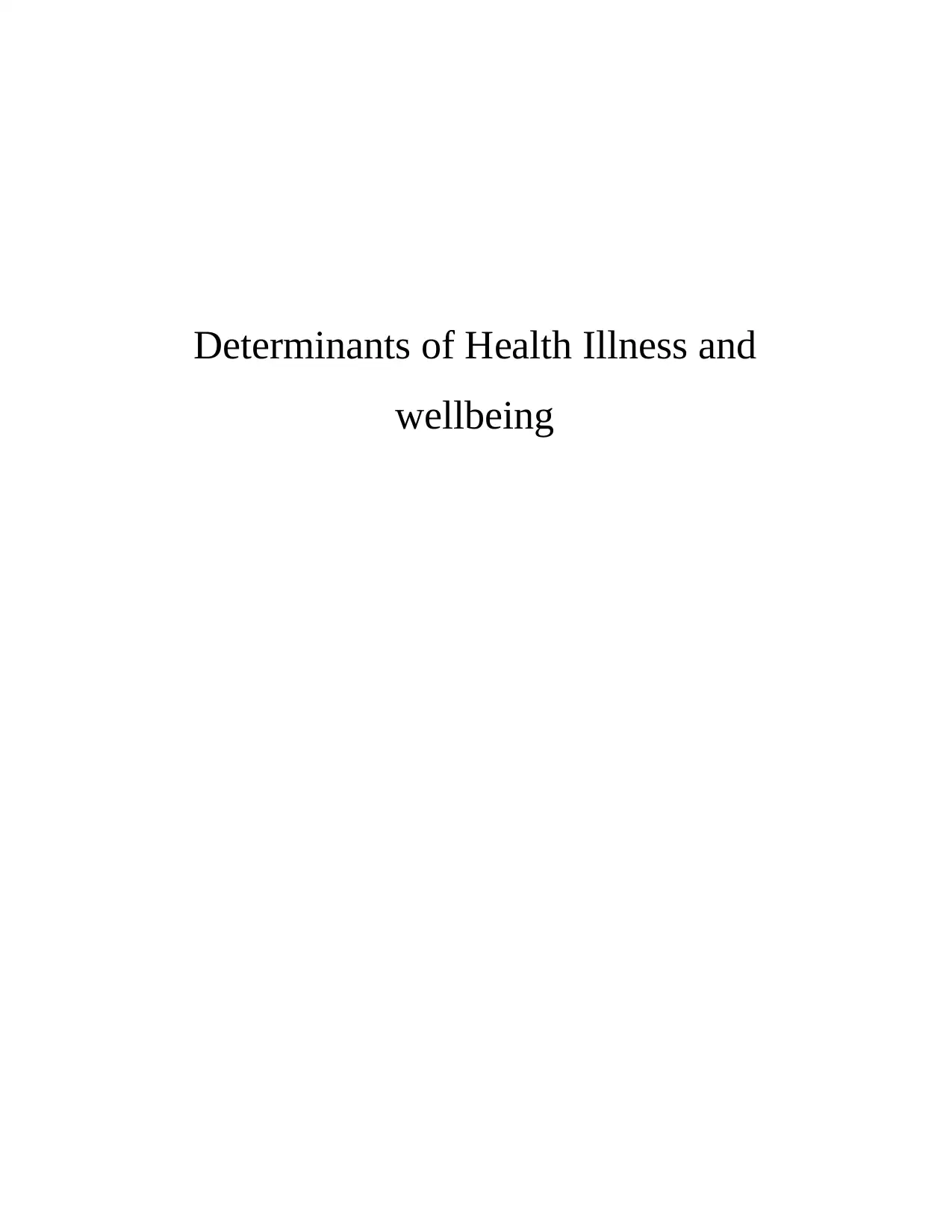
Determinants of Health Illness and
wellbeing
wellbeing
Paraphrase This Document
Need a fresh take? Get an instant paraphrase of this document with our AI Paraphraser
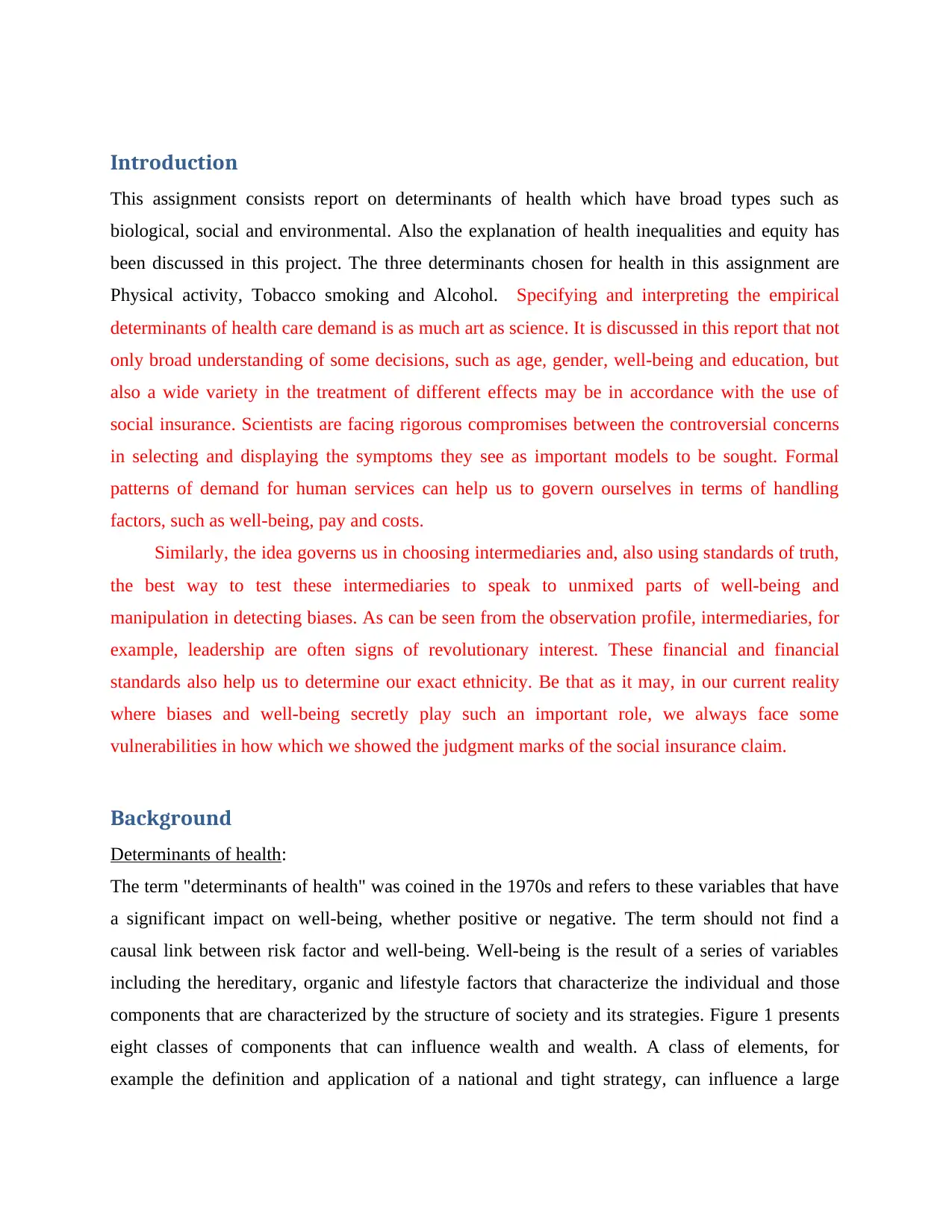
Introduction
This assignment consists report on determinants of health which have broad types such as
biological, social and environmental. Also the explanation of health inequalities and equity has
been discussed in this project. The three determinants chosen for health in this assignment are
Physical activity, Tobacco smoking and Alcohol. Specifying and interpreting the empirical
determinants of health care demand is as much art as science. It is discussed in this report that not
only broad understanding of some decisions, such as age, gender, well-being and education, but
also a wide variety in the treatment of different effects may be in accordance with the use of
social insurance. Scientists are facing rigorous compromises between the controversial concerns
in selecting and displaying the symptoms they see as important models to be sought. Formal
patterns of demand for human services can help us to govern ourselves in terms of handling
factors, such as well-being, pay and costs.
Similarly, the idea governs us in choosing intermediaries and, also using standards of truth,
the best way to test these intermediaries to speak to unmixed parts of well-being and
manipulation in detecting biases. As can be seen from the observation profile, intermediaries, for
example, leadership are often signs of revolutionary interest. These financial and financial
standards also help us to determine our exact ethnicity. Be that as it may, in our current reality
where biases and well-being secretly play such an important role, we always face some
vulnerabilities in how which we showed the judgment marks of the social insurance claim.
Background
Determinants of health:
The term "determinants of health" was coined in the 1970s and refers to these variables that have
a significant impact on well-being, whether positive or negative. The term should not find a
causal link between risk factor and well-being. Well-being is the result of a series of variables
including the hereditary, organic and lifestyle factors that characterize the individual and those
components that are characterized by the structure of society and its strategies. Figure 1 presents
eight classes of components that can influence wealth and wealth. A class of elements, for
example the definition and application of a national and tight strategy, can influence a large
This assignment consists report on determinants of health which have broad types such as
biological, social and environmental. Also the explanation of health inequalities and equity has
been discussed in this project. The three determinants chosen for health in this assignment are
Physical activity, Tobacco smoking and Alcohol. Specifying and interpreting the empirical
determinants of health care demand is as much art as science. It is discussed in this report that not
only broad understanding of some decisions, such as age, gender, well-being and education, but
also a wide variety in the treatment of different effects may be in accordance with the use of
social insurance. Scientists are facing rigorous compromises between the controversial concerns
in selecting and displaying the symptoms they see as important models to be sought. Formal
patterns of demand for human services can help us to govern ourselves in terms of handling
factors, such as well-being, pay and costs.
Similarly, the idea governs us in choosing intermediaries and, also using standards of truth,
the best way to test these intermediaries to speak to unmixed parts of well-being and
manipulation in detecting biases. As can be seen from the observation profile, intermediaries, for
example, leadership are often signs of revolutionary interest. These financial and financial
standards also help us to determine our exact ethnicity. Be that as it may, in our current reality
where biases and well-being secretly play such an important role, we always face some
vulnerabilities in how which we showed the judgment marks of the social insurance claim.
Background
Determinants of health:
The term "determinants of health" was coined in the 1970s and refers to these variables that have
a significant impact on well-being, whether positive or negative. The term should not find a
causal link between risk factor and well-being. Well-being is the result of a series of variables
including the hereditary, organic and lifestyle factors that characterize the individual and those
components that are characterized by the structure of society and its strategies. Figure 1 presents
eight classes of components that can influence wealth and wealth. A class of elements, for
example the definition and application of a national and tight strategy, can influence a large

number of medical problems within and beyond the wellness sector. Improving the state of well-
being of the population means that strategies and interventions outside the well-being component
should be simultaneously with biochemical and general well-being approaches (Bunker, Frazier
and Mosteller, 1995).
The range of individual, social, financial and natural factors that influence well-being is
called the determinants of health.
It is the interconnection of these elements that determines the well-being of individuals and
people. Like these lines, mediation aimed at different wellness decisions is expected to be
powerful. Determinants of health extend beyond the boundaries of current areas of social security
and general well-being; sectors such as management, housing, transport, agri-food and location
can contribute significantly to the development of the well-being of the population.
Broad types of determinants
Determinants of health can be natural, behavioral, socio-cultural, financial and biological.
Altogether, the signs of well-being can be distinguished into four main types: nutrition, lifestyle,
hereditary condition and characteristics, which are similar to the four pillars of the establishment.
Once one of the pillars of well-being decisions grows, an emotional support network is needed.
This is considered to be the fifth hallmark of well-being and includes clinical consideration.
Accurate control of these symptoms will lead to more informed well-being.
Biological:
Some biological and genetic factors influence apparent populations more than others. For
example, more seasonal adults are more likely to have less fortunate well-being than teenagers
due to the physical and intellectual effects of maturity.
Sickle cell disease is a common hereditary diagnostic tool for well-being. A sick cell is a
condition that people have when both protectors provide qualities for a sickle cell. The quality is
typical in people with ancestors from the countries of West Africa, the Mediterranean, South or
Central America, the Caribbean islands, India and Saudi Arabia (Bunker, Frazier and Mosteller,
1995).
Social:
being of the population means that strategies and interventions outside the well-being component
should be simultaneously with biochemical and general well-being approaches (Bunker, Frazier
and Mosteller, 1995).
The range of individual, social, financial and natural factors that influence well-being is
called the determinants of health.
It is the interconnection of these elements that determines the well-being of individuals and
people. Like these lines, mediation aimed at different wellness decisions is expected to be
powerful. Determinants of health extend beyond the boundaries of current areas of social security
and general well-being; sectors such as management, housing, transport, agri-food and location
can contribute significantly to the development of the well-being of the population.
Broad types of determinants
Determinants of health can be natural, behavioral, socio-cultural, financial and biological.
Altogether, the signs of well-being can be distinguished into four main types: nutrition, lifestyle,
hereditary condition and characteristics, which are similar to the four pillars of the establishment.
Once one of the pillars of well-being decisions grows, an emotional support network is needed.
This is considered to be the fifth hallmark of well-being and includes clinical consideration.
Accurate control of these symptoms will lead to more informed well-being.
Biological:
Some biological and genetic factors influence apparent populations more than others. For
example, more seasonal adults are more likely to have less fortunate well-being than teenagers
due to the physical and intellectual effects of maturity.
Sickle cell disease is a common hereditary diagnostic tool for well-being. A sick cell is a
condition that people have when both protectors provide qualities for a sickle cell. The quality is
typical in people with ancestors from the countries of West Africa, the Mediterranean, South or
Central America, the Caribbean islands, India and Saudi Arabia (Bunker, Frazier and Mosteller,
1995).
Social:
⊘ This is a preview!⊘
Do you want full access?
Subscribe today to unlock all pages.

Trusted by 1+ million students worldwide
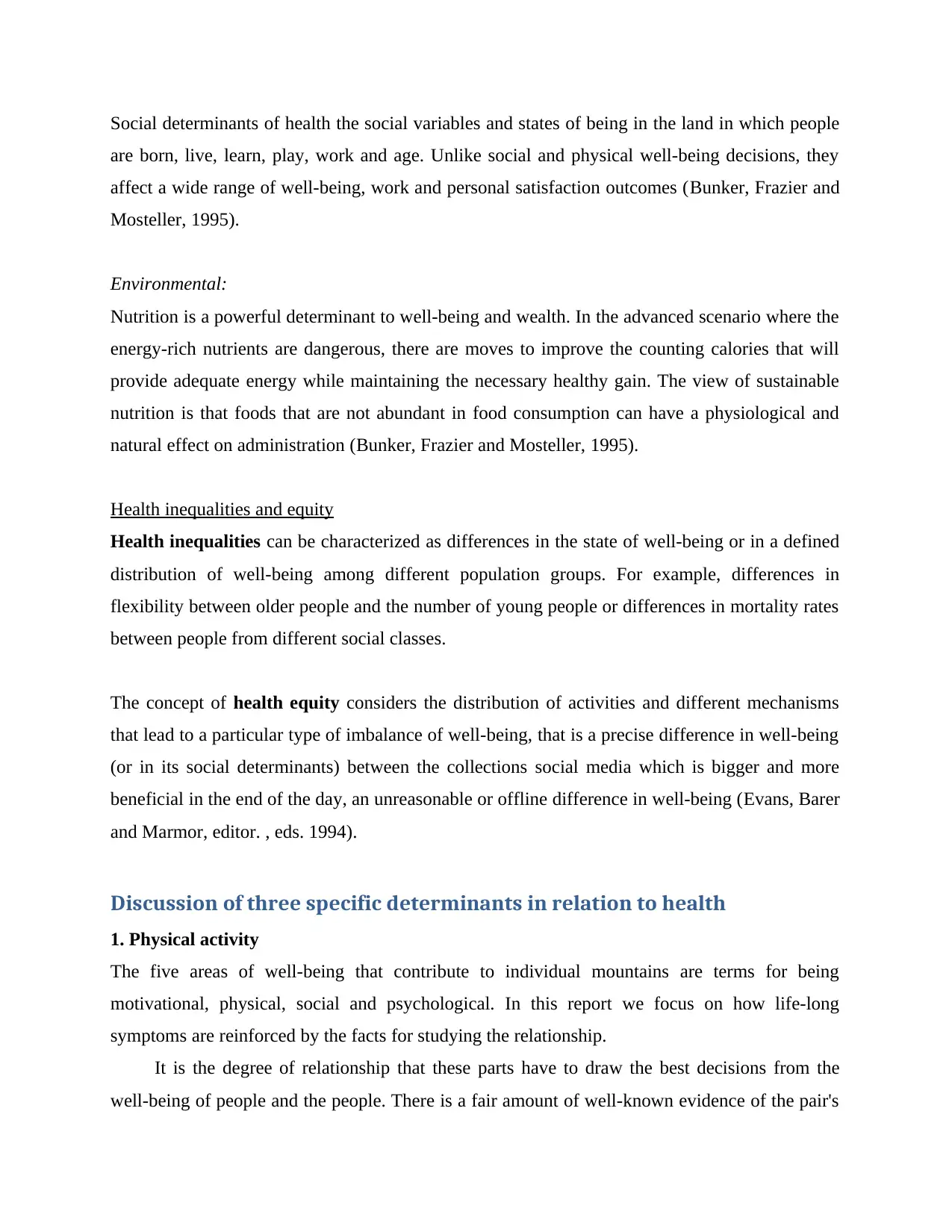
Social determinants of health the social variables and states of being in the land in which people
are born, live, learn, play, work and age. Unlike social and physical well-being decisions, they
affect a wide range of well-being, work and personal satisfaction outcomes (Bunker, Frazier and
Mosteller, 1995).
Environmental:
Nutrition is a powerful determinant to well-being and wealth. In the advanced scenario where the
energy-rich nutrients are dangerous, there are moves to improve the counting calories that will
provide adequate energy while maintaining the necessary healthy gain. The view of sustainable
nutrition is that foods that are not abundant in food consumption can have a physiological and
natural effect on administration (Bunker, Frazier and Mosteller, 1995).
Health inequalities and equity
Health inequalities can be characterized as differences in the state of well-being or in a defined
distribution of well-being among different population groups. For example, differences in
flexibility between older people and the number of young people or differences in mortality rates
between people from different social classes.
The concept of health equity considers the distribution of activities and different mechanisms
that lead to a particular type of imbalance of well-being, that is a precise difference in well-being
(or in its social determinants) between the collections social media which is bigger and more
beneficial in the end of the day, an unreasonable or offline difference in well-being (Evans, Barer
and Marmor, editor. , eds. 1994).
Discussion of three specific determinants in relation to health
1. Physical activity
The five areas of well-being that contribute to individual mountains are terms for being
motivational, physical, social and psychological. In this report we focus on how life-long
symptoms are reinforced by the facts for studying the relationship.
It is the degree of relationship that these parts have to draw the best decisions from the
well-being of people and the people. There is a fair amount of well-known evidence of the pair's
are born, live, learn, play, work and age. Unlike social and physical well-being decisions, they
affect a wide range of well-being, work and personal satisfaction outcomes (Bunker, Frazier and
Mosteller, 1995).
Environmental:
Nutrition is a powerful determinant to well-being and wealth. In the advanced scenario where the
energy-rich nutrients are dangerous, there are moves to improve the counting calories that will
provide adequate energy while maintaining the necessary healthy gain. The view of sustainable
nutrition is that foods that are not abundant in food consumption can have a physiological and
natural effect on administration (Bunker, Frazier and Mosteller, 1995).
Health inequalities and equity
Health inequalities can be characterized as differences in the state of well-being or in a defined
distribution of well-being among different population groups. For example, differences in
flexibility between older people and the number of young people or differences in mortality rates
between people from different social classes.
The concept of health equity considers the distribution of activities and different mechanisms
that lead to a particular type of imbalance of well-being, that is a precise difference in well-being
(or in its social determinants) between the collections social media which is bigger and more
beneficial in the end of the day, an unreasonable or offline difference in well-being (Evans, Barer
and Marmor, editor. , eds. 1994).
Discussion of three specific determinants in relation to health
1. Physical activity
The five areas of well-being that contribute to individual mountains are terms for being
motivational, physical, social and psychological. In this report we focus on how life-long
symptoms are reinforced by the facts for studying the relationship.
It is the degree of relationship that these parts have to draw the best decisions from the
well-being of people and the people. There is a fair amount of well-known evidence of the pair's
Paraphrase This Document
Need a fresh take? Get an instant paraphrase of this document with our AI Paraphraser
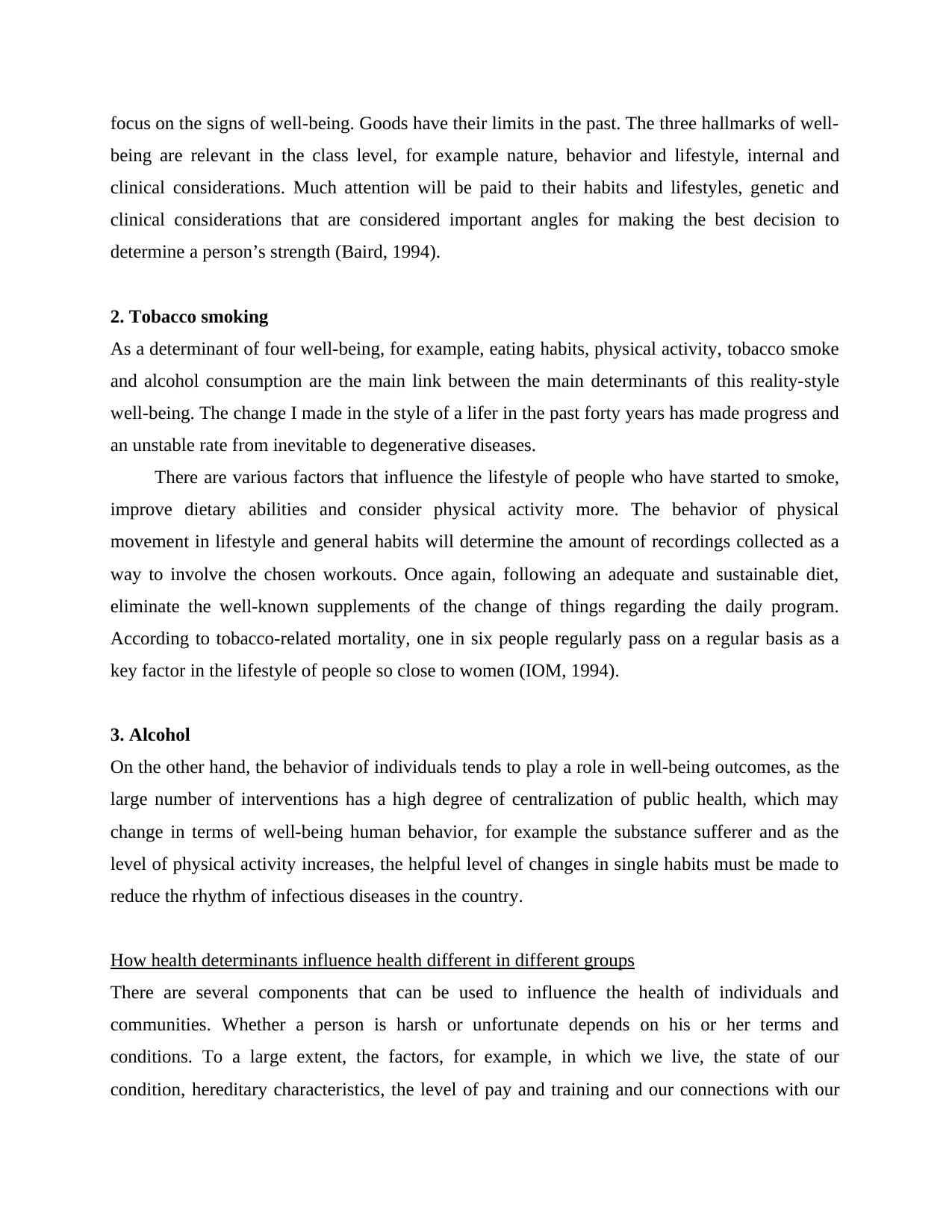
focus on the signs of well-being. Goods have their limits in the past. The three hallmarks of well-
being are relevant in the class level, for example nature, behavior and lifestyle, internal and
clinical considerations. Much attention will be paid to their habits and lifestyles, genetic and
clinical considerations that are considered important angles for making the best decision to
determine a person’s strength (Baird, 1994).
2. Tobacco smoking
As a determinant of four well-being, for example, eating habits, physical activity, tobacco smoke
and alcohol consumption are the main link between the main determinants of this reality-style
well-being. The change I made in the style of a lifer in the past forty years has made progress and
an unstable rate from inevitable to degenerative diseases.
There are various factors that influence the lifestyle of people who have started to smoke,
improve dietary abilities and consider physical activity more. The behavior of physical
movement in lifestyle and general habits will determine the amount of recordings collected as a
way to involve the chosen workouts. Once again, following an adequate and sustainable diet,
eliminate the well-known supplements of the change of things regarding the daily program.
According to tobacco-related mortality, one in six people regularly pass on a regular basis as a
key factor in the lifestyle of people so close to women (IOM, 1994).
3. Alcohol
On the other hand, the behavior of individuals tends to play a role in well-being outcomes, as the
large number of interventions has a high degree of centralization of public health, which may
change in terms of well-being human behavior, for example the substance sufferer and as the
level of physical activity increases, the helpful level of changes in single habits must be made to
reduce the rhythm of infectious diseases in the country.
How health determinants influence health different in different groups
There are several components that can be used to influence the health of individuals and
communities. Whether a person is harsh or unfortunate depends on his or her terms and
conditions. To a large extent, the factors, for example, in which we live, the state of our
condition, hereditary characteristics, the level of pay and training and our connections with our
being are relevant in the class level, for example nature, behavior and lifestyle, internal and
clinical considerations. Much attention will be paid to their habits and lifestyles, genetic and
clinical considerations that are considered important angles for making the best decision to
determine a person’s strength (Baird, 1994).
2. Tobacco smoking
As a determinant of four well-being, for example, eating habits, physical activity, tobacco smoke
and alcohol consumption are the main link between the main determinants of this reality-style
well-being. The change I made in the style of a lifer in the past forty years has made progress and
an unstable rate from inevitable to degenerative diseases.
There are various factors that influence the lifestyle of people who have started to smoke,
improve dietary abilities and consider physical activity more. The behavior of physical
movement in lifestyle and general habits will determine the amount of recordings collected as a
way to involve the chosen workouts. Once again, following an adequate and sustainable diet,
eliminate the well-known supplements of the change of things regarding the daily program.
According to tobacco-related mortality, one in six people regularly pass on a regular basis as a
key factor in the lifestyle of people so close to women (IOM, 1994).
3. Alcohol
On the other hand, the behavior of individuals tends to play a role in well-being outcomes, as the
large number of interventions has a high degree of centralization of public health, which may
change in terms of well-being human behavior, for example the substance sufferer and as the
level of physical activity increases, the helpful level of changes in single habits must be made to
reduce the rhythm of infectious diseases in the country.
How health determinants influence health different in different groups
There are several components that can be used to influence the health of individuals and
communities. Whether a person is harsh or unfortunate depends on his or her terms and
conditions. To a large extent, the factors, for example, in which we live, the state of our
condition, hereditary characteristics, the level of pay and training and our connections with our

loved ones have a definite influence on well-being, while the factors such as often considered, for
example, access to and use of the benefits of human services is often unaffected (Evans and
Stoddart, 1994).
It is essential that health care workers dedicated to improving well-being increase their
profitability by being committed to the “upstream” causes of network wellbeing and by
participating in approaches to change the broad practices, frameworks and situations that shape
social situations and money, which in turn have a definite impact on well-being (Falciglia and
Norton, 1994). Lover et al represent open doors for medical services capable of addressing the
social symptoms of well-being. They suggest that, in order to improve the well-being of families
and networks and ensure the best effect for the profitability of products, wellness specialists need
to expand the collection of skills and exercises both with the patients half of them and in a
residential area (Dietz, W.H. 1994).
Things to be done to positively influence the determinant of health to improve individual and
community health
Many factors can influence by a number of elements to promote well-being. You can think of
different wellness decisions to make changes at the individual level, at the network level or both.
Not all parts of every broad wellness decision are synonymous with intervention, however much
they may be. For example, the social situation of ex-restricted residents can be improved by
expanding contacts with others, but their hereditary medicines still cannot be changed (Entwisle,
1995).
The time to estimate changes in well-being generally varies, from days to decades. Some
fertile mediators will produce clear results within a year or two, while others can be detected with
long periods of inactivity before the necessary changes in well-being are seen (Berkman and
Syme, 1979). The effect of a transition can also have an effect when communicated to an
individual because, as mentioned above, all signs of being "fundamental times" in a human turn
of events. Some interventions in adolescence may have delayed this phase by lasting results.
Likewise, the effects of the centralized population need to be considered. Small changes at the
individual level can have a significant impact when applied to an entire network (Blum, 1981).
The traditional targets for intervention have been specific diseases or behaviors, and
categorical funding streams for both research and the delivery of services encourage this
example, access to and use of the benefits of human services is often unaffected (Evans and
Stoddart, 1994).
It is essential that health care workers dedicated to improving well-being increase their
profitability by being committed to the “upstream” causes of network wellbeing and by
participating in approaches to change the broad practices, frameworks and situations that shape
social situations and money, which in turn have a definite impact on well-being (Falciglia and
Norton, 1994). Lover et al represent open doors for medical services capable of addressing the
social symptoms of well-being. They suggest that, in order to improve the well-being of families
and networks and ensure the best effect for the profitability of products, wellness specialists need
to expand the collection of skills and exercises both with the patients half of them and in a
residential area (Dietz, W.H. 1994).
Things to be done to positively influence the determinant of health to improve individual and
community health
Many factors can influence by a number of elements to promote well-being. You can think of
different wellness decisions to make changes at the individual level, at the network level or both.
Not all parts of every broad wellness decision are synonymous with intervention, however much
they may be. For example, the social situation of ex-restricted residents can be improved by
expanding contacts with others, but their hereditary medicines still cannot be changed (Entwisle,
1995).
The time to estimate changes in well-being generally varies, from days to decades. Some
fertile mediators will produce clear results within a year or two, while others can be detected with
long periods of inactivity before the necessary changes in well-being are seen (Berkman and
Syme, 1979). The effect of a transition can also have an effect when communicated to an
individual because, as mentioned above, all signs of being "fundamental times" in a human turn
of events. Some interventions in adolescence may have delayed this phase by lasting results.
Likewise, the effects of the centralized population need to be considered. Small changes at the
individual level can have a significant impact when applied to an entire network (Blum, 1981).
The traditional targets for intervention have been specific diseases or behaviors, and
categorical funding streams for both research and the delivery of services encourage this
⊘ This is a preview!⊘
Do you want full access?
Subscribe today to unlock all pages.

Trusted by 1+ million students worldwide
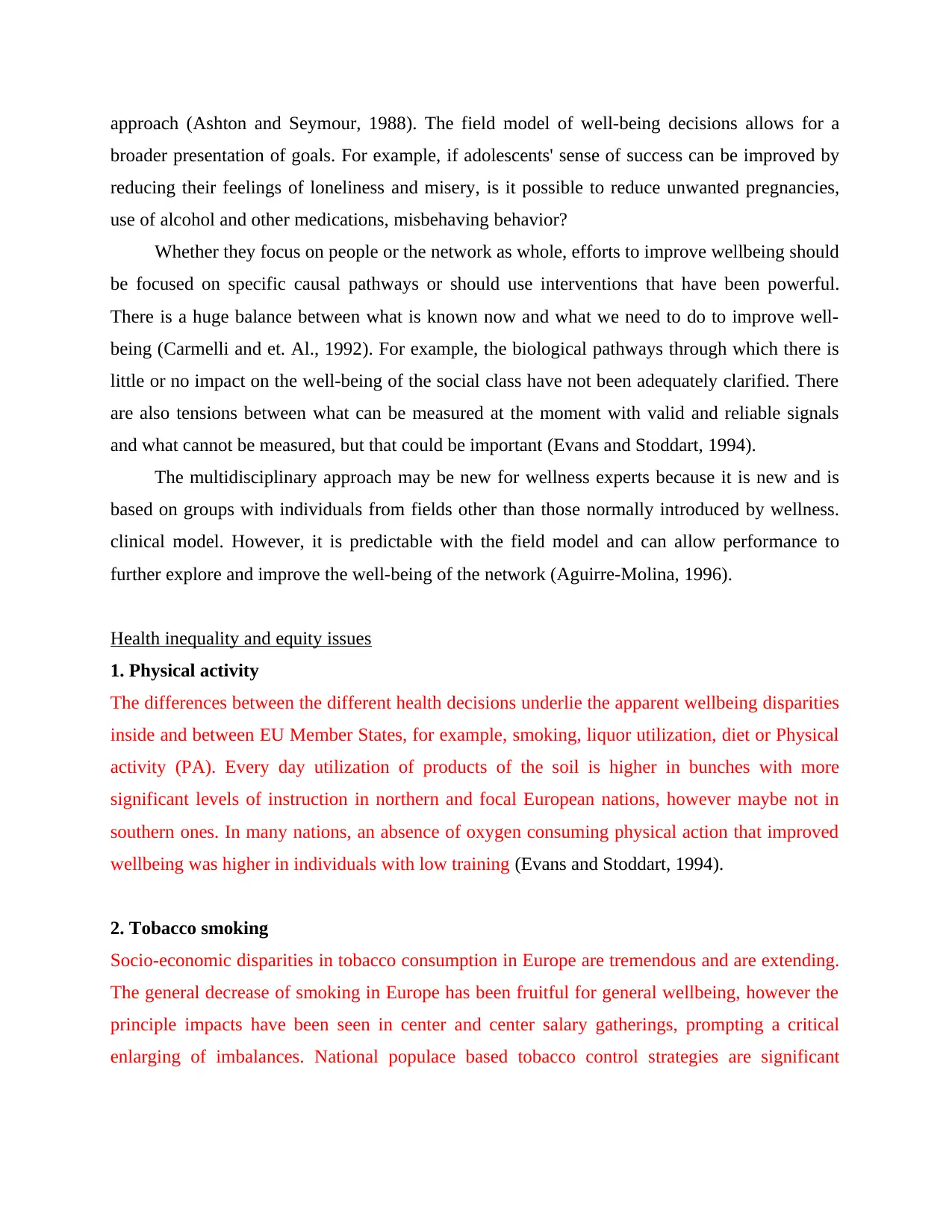
approach (Ashton and Seymour, 1988). The field model of well-being decisions allows for a
broader presentation of goals. For example, if adolescents' sense of success can be improved by
reducing their feelings of loneliness and misery, is it possible to reduce unwanted pregnancies,
use of alcohol and other medications, misbehaving behavior?
Whether they focus on people or the network as whole, efforts to improve wellbeing should
be focused on specific causal pathways or should use interventions that have been powerful.
There is a huge balance between what is known now and what we need to do to improve well-
being (Carmelli and et. Al., 1992). For example, the biological pathways through which there is
little or no impact on the well-being of the social class have not been adequately clarified. There
are also tensions between what can be measured at the moment with valid and reliable signals
and what cannot be measured, but that could be important (Evans and Stoddart, 1994).
The multidisciplinary approach may be new for wellness experts because it is new and is
based on groups with individuals from fields other than those normally introduced by wellness.
clinical model. However, it is predictable with the field model and can allow performance to
further explore and improve the well-being of the network (Aguirre-Molina, 1996).
Health inequality and equity issues
1. Physical activity
The differences between the different health decisions underlie the apparent wellbeing disparities
inside and between EU Member States, for example, smoking, liquor utilization, diet or Physical
activity (PA). Every day utilization of products of the soil is higher in bunches with more
significant levels of instruction in northern and focal European nations, however maybe not in
southern ones. In many nations, an absence of oxygen consuming physical action that improved
wellbeing was higher in individuals with low training (Evans and Stoddart, 1994).
2. Tobacco smoking
Socio-economic disparities in tobacco consumption in Europe are tremendous and are extending.
The general decrease of smoking in Europe has been fruitful for general wellbeing, however the
principle impacts have been seen in center and center salary gatherings, prompting a critical
enlarging of imbalances. National populace based tobacco control strategies are significant
broader presentation of goals. For example, if adolescents' sense of success can be improved by
reducing their feelings of loneliness and misery, is it possible to reduce unwanted pregnancies,
use of alcohol and other medications, misbehaving behavior?
Whether they focus on people or the network as whole, efforts to improve wellbeing should
be focused on specific causal pathways or should use interventions that have been powerful.
There is a huge balance between what is known now and what we need to do to improve well-
being (Carmelli and et. Al., 1992). For example, the biological pathways through which there is
little or no impact on the well-being of the social class have not been adequately clarified. There
are also tensions between what can be measured at the moment with valid and reliable signals
and what cannot be measured, but that could be important (Evans and Stoddart, 1994).
The multidisciplinary approach may be new for wellness experts because it is new and is
based on groups with individuals from fields other than those normally introduced by wellness.
clinical model. However, it is predictable with the field model and can allow performance to
further explore and improve the well-being of the network (Aguirre-Molina, 1996).
Health inequality and equity issues
1. Physical activity
The differences between the different health decisions underlie the apparent wellbeing disparities
inside and between EU Member States, for example, smoking, liquor utilization, diet or Physical
activity (PA). Every day utilization of products of the soil is higher in bunches with more
significant levels of instruction in northern and focal European nations, however maybe not in
southern ones. In many nations, an absence of oxygen consuming physical action that improved
wellbeing was higher in individuals with low training (Evans and Stoddart, 1994).
2. Tobacco smoking
Socio-economic disparities in tobacco consumption in Europe are tremendous and are extending.
The general decrease of smoking in Europe has been fruitful for general wellbeing, however the
principle impacts have been seen in center and center salary gatherings, prompting a critical
enlarging of imbalances. National populace based tobacco control strategies are significant
Paraphrase This Document
Need a fresh take? Get an instant paraphrase of this document with our AI Paraphraser
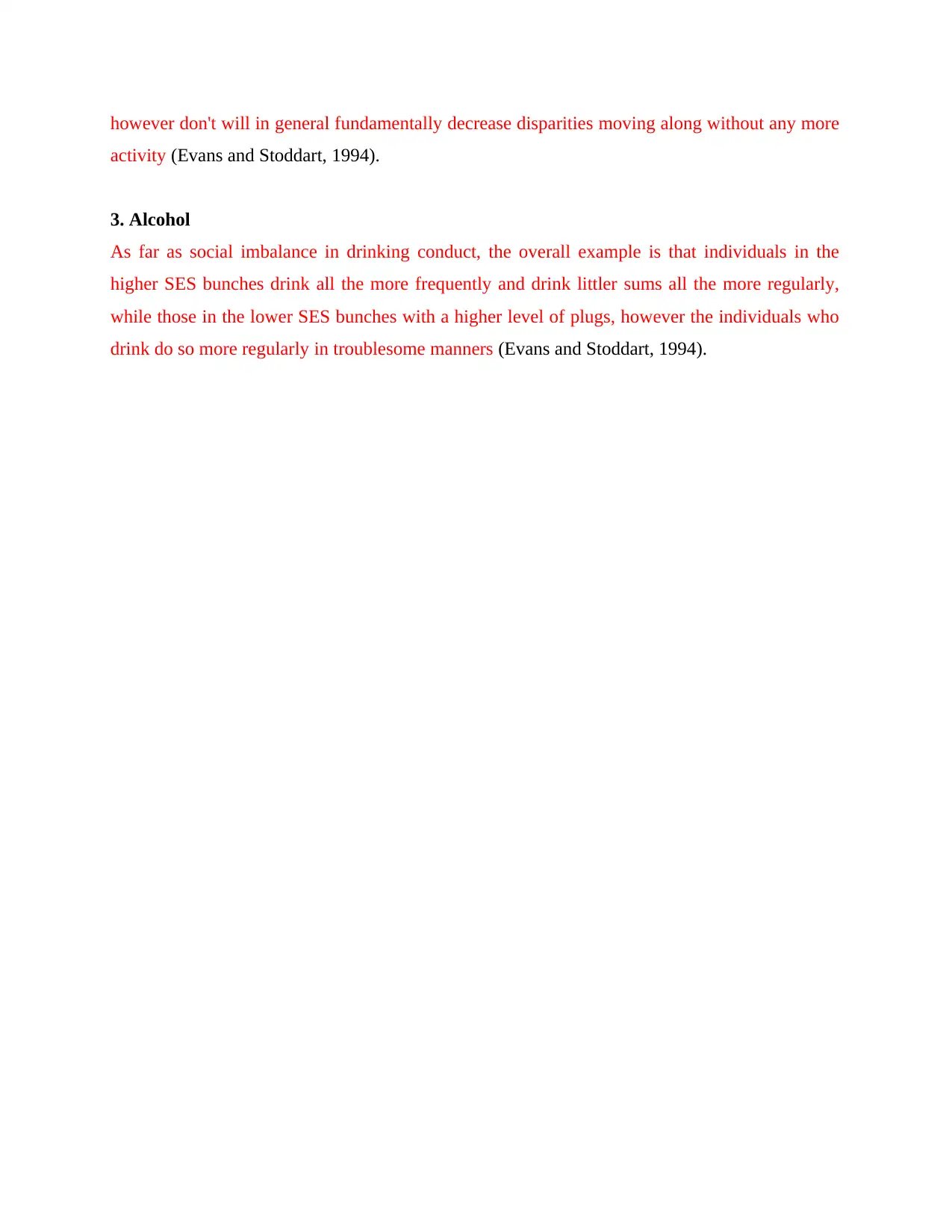
however don't will in general fundamentally decrease disparities moving along without any more
activity (Evans and Stoddart, 1994).
3. Alcohol
As far as social imbalance in drinking conduct, the overall example is that individuals in the
higher SES bunches drink all the more frequently and drink littler sums all the more regularly,
while those in the lower SES bunches with a higher level of plugs, however the individuals who
drink do so more regularly in troublesome manners (Evans and Stoddart, 1994).
activity (Evans and Stoddart, 1994).
3. Alcohol
As far as social imbalance in drinking conduct, the overall example is that individuals in the
higher SES bunches drink all the more frequently and drink littler sums all the more regularly,
while those in the lower SES bunches with a higher level of plugs, however the individuals who
drink do so more regularly in troublesome manners (Evans and Stoddart, 1994).
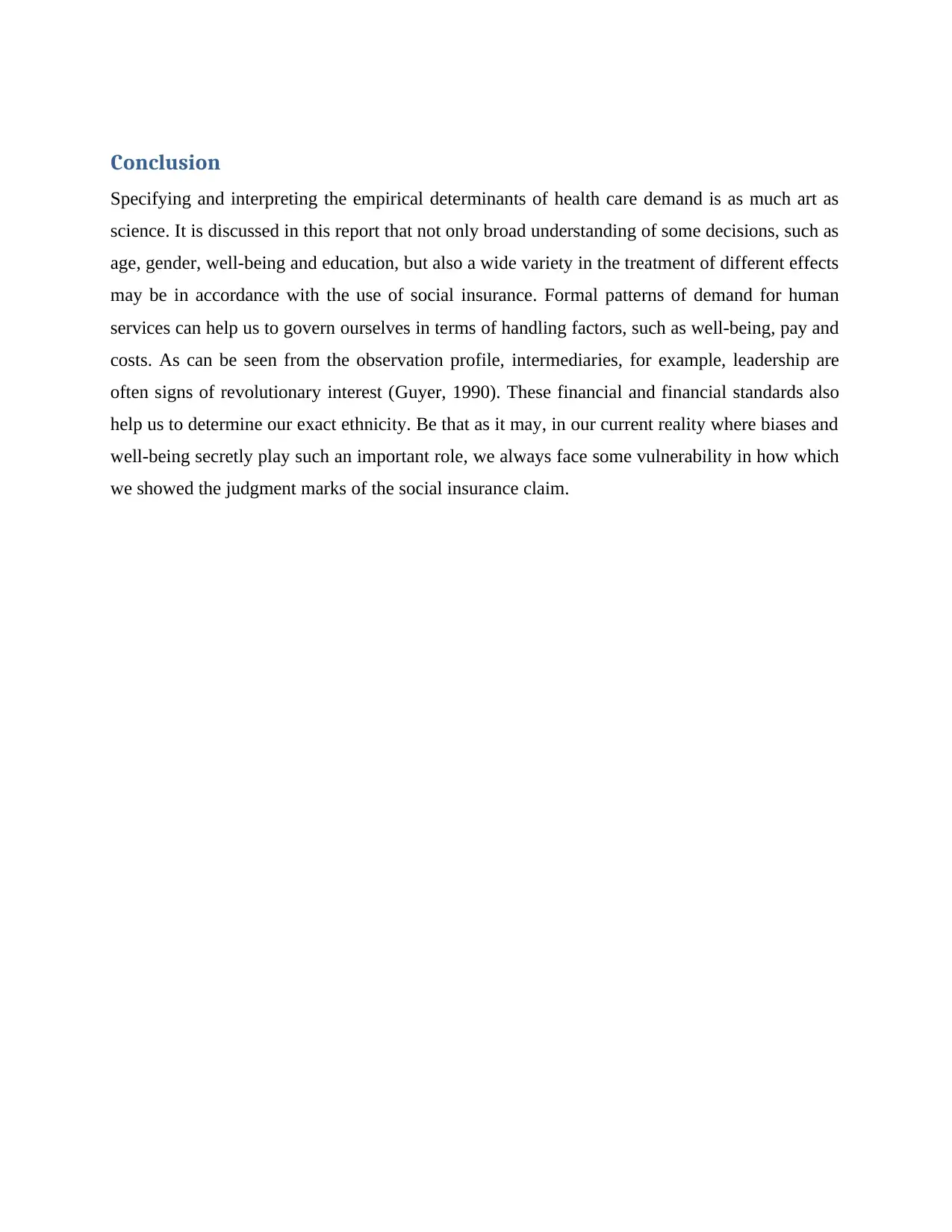
Conclusion
Specifying and interpreting the empirical determinants of health care demand is as much art as
science. It is discussed in this report that not only broad understanding of some decisions, such as
age, gender, well-being and education, but also a wide variety in the treatment of different effects
may be in accordance with the use of social insurance. Formal patterns of demand for human
services can help us to govern ourselves in terms of handling factors, such as well-being, pay and
costs. As can be seen from the observation profile, intermediaries, for example, leadership are
often signs of revolutionary interest (Guyer, 1990). These financial and financial standards also
help us to determine our exact ethnicity. Be that as it may, in our current reality where biases and
well-being secretly play such an important role, we always face some vulnerability in how which
we showed the judgment marks of the social insurance claim.
Specifying and interpreting the empirical determinants of health care demand is as much art as
science. It is discussed in this report that not only broad understanding of some decisions, such as
age, gender, well-being and education, but also a wide variety in the treatment of different effects
may be in accordance with the use of social insurance. Formal patterns of demand for human
services can help us to govern ourselves in terms of handling factors, such as well-being, pay and
costs. As can be seen from the observation profile, intermediaries, for example, leadership are
often signs of revolutionary interest (Guyer, 1990). These financial and financial standards also
help us to determine our exact ethnicity. Be that as it may, in our current reality where biases and
well-being secretly play such an important role, we always face some vulnerability in how which
we showed the judgment marks of the social insurance claim.
⊘ This is a preview!⊘
Do you want full access?
Subscribe today to unlock all pages.

Trusted by 1+ million students worldwide
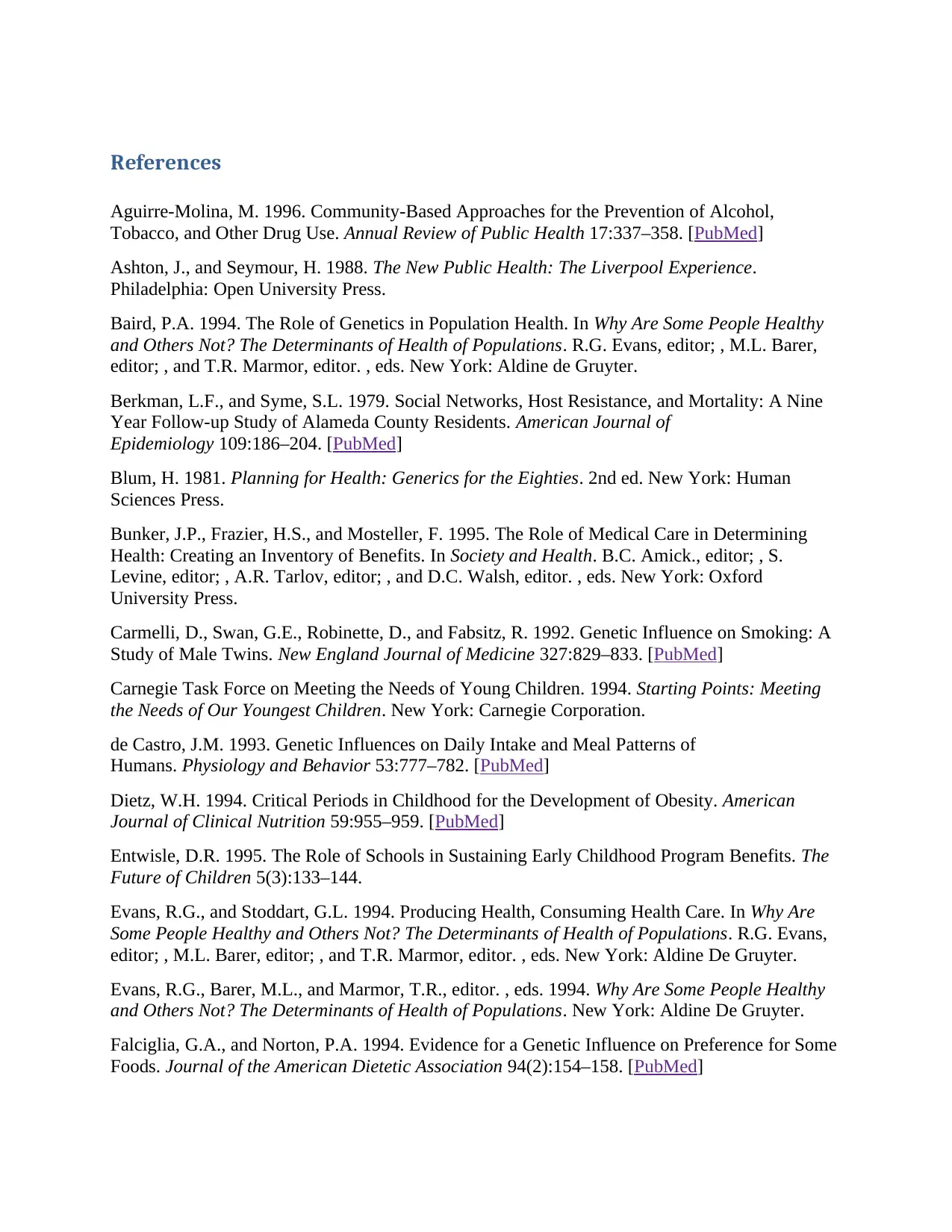
References
Aguirre-Molina, M. 1996. Community-Based Approaches for the Prevention of Alcohol,
Tobacco, and Other Drug Use. Annual Review of Public Health 17:337–358. [PubMed]
Ashton, J., and Seymour, H. 1988. The New Public Health: The Liverpool Experience.
Philadelphia: Open University Press.
Baird, P.A. 1994. The Role of Genetics in Population Health. In Why Are Some People Healthy
and Others Not? The Determinants of Health of Populations. R.G. Evans, editor; , M.L. Barer,
editor; , and T.R. Marmor, editor. , eds. New York: Aldine de Gruyter.
Berkman, L.F., and Syme, S.L. 1979. Social Networks, Host Resistance, and Mortality: A Nine
Year Follow-up Study of Alameda County Residents. American Journal of
Epidemiology 109:186–204. [PubMed]
Blum, H. 1981. Planning for Health: Generics for the Eighties. 2nd ed. New York: Human
Sciences Press.
Bunker, J.P., Frazier, H.S., and Mosteller, F. 1995. The Role of Medical Care in Determining
Health: Creating an Inventory of Benefits. In Society and Health. B.C. Amick., editor; , S.
Levine, editor; , A.R. Tarlov, editor; , and D.C. Walsh, editor. , eds. New York: Oxford
University Press.
Carmelli, D., Swan, G.E., Robinette, D., and Fabsitz, R. 1992. Genetic Influence on Smoking: A
Study of Male Twins. New England Journal of Medicine 327:829–833. [PubMed]
Carnegie Task Force on Meeting the Needs of Young Children. 1994. Starting Points: Meeting
the Needs of Our Youngest Children. New York: Carnegie Corporation.
de Castro, J.M. 1993. Genetic Influences on Daily Intake and Meal Patterns of
Humans. Physiology and Behavior 53:777–782. [PubMed]
Dietz, W.H. 1994. Critical Periods in Childhood for the Development of Obesity. American
Journal of Clinical Nutrition 59:955–959. [PubMed]
Entwisle, D.R. 1995. The Role of Schools in Sustaining Early Childhood Program Benefits. The
Future of Children 5(3):133–144.
Evans, R.G., and Stoddart, G.L. 1994. Producing Health, Consuming Health Care. In Why Are
Some People Healthy and Others Not? The Determinants of Health of Populations. R.G. Evans,
editor; , M.L. Barer, editor; , and T.R. Marmor, editor. , eds. New York: Aldine De Gruyter.
Evans, R.G., Barer, M.L., and Marmor, T.R., editor. , eds. 1994. Why Are Some People Healthy
and Others Not? The Determinants of Health of Populations. New York: Aldine De Gruyter.
Falciglia, G.A., and Norton, P.A. 1994. Evidence for a Genetic Influence on Preference for Some
Foods. Journal of the American Dietetic Association 94(2):154–158. [PubMed]
Aguirre-Molina, M. 1996. Community-Based Approaches for the Prevention of Alcohol,
Tobacco, and Other Drug Use. Annual Review of Public Health 17:337–358. [PubMed]
Ashton, J., and Seymour, H. 1988. The New Public Health: The Liverpool Experience.
Philadelphia: Open University Press.
Baird, P.A. 1994. The Role of Genetics in Population Health. In Why Are Some People Healthy
and Others Not? The Determinants of Health of Populations. R.G. Evans, editor; , M.L. Barer,
editor; , and T.R. Marmor, editor. , eds. New York: Aldine de Gruyter.
Berkman, L.F., and Syme, S.L. 1979. Social Networks, Host Resistance, and Mortality: A Nine
Year Follow-up Study of Alameda County Residents. American Journal of
Epidemiology 109:186–204. [PubMed]
Blum, H. 1981. Planning for Health: Generics for the Eighties. 2nd ed. New York: Human
Sciences Press.
Bunker, J.P., Frazier, H.S., and Mosteller, F. 1995. The Role of Medical Care in Determining
Health: Creating an Inventory of Benefits. In Society and Health. B.C. Amick., editor; , S.
Levine, editor; , A.R. Tarlov, editor; , and D.C. Walsh, editor. , eds. New York: Oxford
University Press.
Carmelli, D., Swan, G.E., Robinette, D., and Fabsitz, R. 1992. Genetic Influence on Smoking: A
Study of Male Twins. New England Journal of Medicine 327:829–833. [PubMed]
Carnegie Task Force on Meeting the Needs of Young Children. 1994. Starting Points: Meeting
the Needs of Our Youngest Children. New York: Carnegie Corporation.
de Castro, J.M. 1993. Genetic Influences on Daily Intake and Meal Patterns of
Humans. Physiology and Behavior 53:777–782. [PubMed]
Dietz, W.H. 1994. Critical Periods in Childhood for the Development of Obesity. American
Journal of Clinical Nutrition 59:955–959. [PubMed]
Entwisle, D.R. 1995. The Role of Schools in Sustaining Early Childhood Program Benefits. The
Future of Children 5(3):133–144.
Evans, R.G., and Stoddart, G.L. 1994. Producing Health, Consuming Health Care. In Why Are
Some People Healthy and Others Not? The Determinants of Health of Populations. R.G. Evans,
editor; , M.L. Barer, editor; , and T.R. Marmor, editor. , eds. New York: Aldine De Gruyter.
Evans, R.G., Barer, M.L., and Marmor, T.R., editor. , eds. 1994. Why Are Some People Healthy
and Others Not? The Determinants of Health of Populations. New York: Aldine De Gruyter.
Falciglia, G.A., and Norton, P.A. 1994. Evidence for a Genetic Influence on Preference for Some
Foods. Journal of the American Dietetic Association 94(2):154–158. [PubMed]
Paraphrase This Document
Need a fresh take? Get an instant paraphrase of this document with our AI Paraphraser

Guyer, B. 1990. The Evolution and Future Role of Title V. In Children in a Changing Health
System: Assessments and Proposals for Reform. M. Schlesinger, editor; and L. Eisenberg,
editor. , eds. Baltimore: Johns Hopkins University Press.
IOM (Institute of Medicine). 1988. The Future of Public Health. Washington, D.C.: National
Academy Press.
IOM. 1994. Growing Up Tobacco Free: Preventing Nicotine Addiction in Children and Youths.
B.S. Lynch, editor; and R.J. Bonnie, editor. , eds. Washington, D.C.: National Academy Press.
System: Assessments and Proposals for Reform. M. Schlesinger, editor; and L. Eisenberg,
editor. , eds. Baltimore: Johns Hopkins University Press.
IOM (Institute of Medicine). 1988. The Future of Public Health. Washington, D.C.: National
Academy Press.
IOM. 1994. Growing Up Tobacco Free: Preventing Nicotine Addiction in Children and Youths.
B.S. Lynch, editor; and R.J. Bonnie, editor. , eds. Washington, D.C.: National Academy Press.
1 out of 11
Related Documents
Your All-in-One AI-Powered Toolkit for Academic Success.
+13062052269
info@desklib.com
Available 24*7 on WhatsApp / Email
![[object Object]](/_next/static/media/star-bottom.7253800d.svg)
Unlock your academic potential
Copyright © 2020–2025 A2Z Services. All Rights Reserved. Developed and managed by ZUCOL.




